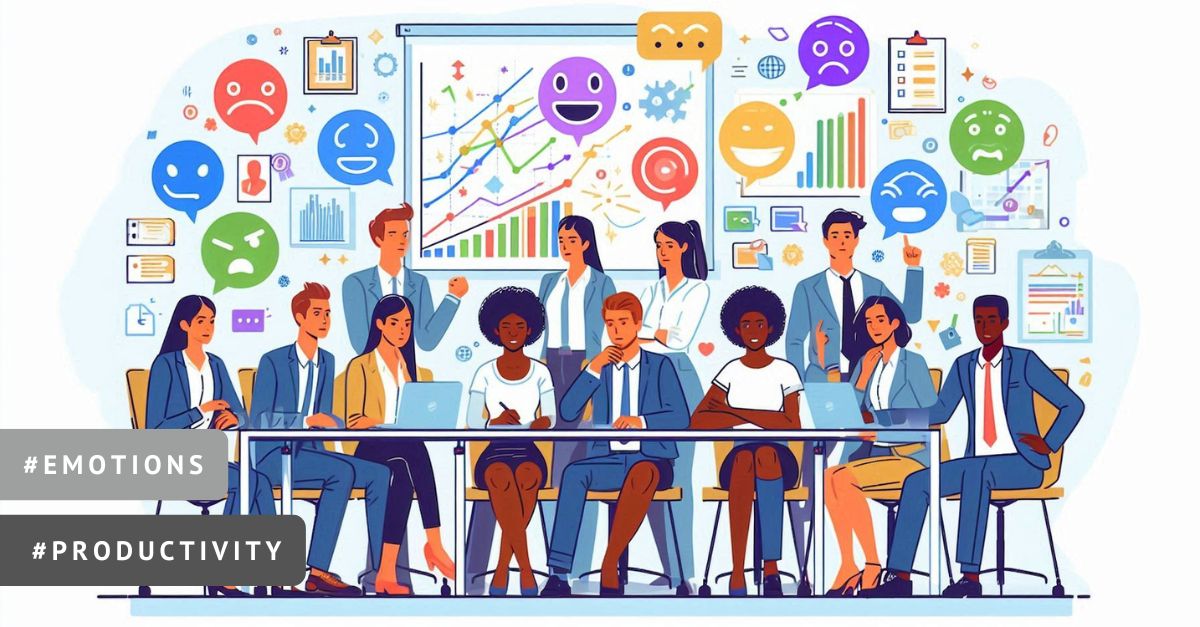
Emotions and productivity
Did you know that excited and wounded up people are more productive?
There’s a long-held belief that professionalism means leaving emotions at the door. Let’s put our emotions aside – how often have we heard this in a workplace meeting? But the reality is, we don’t stop being human when we start working. Emotions are not only natural but deeply intertwined with how we perform at work.
The Science Behind Emotions at Work
At the Challenges of Project Management – Psychology–Team–Agile conference, psychologist and agile coach Łukasz Czaja presented a 3-year study involving IT and administration teams. Over 42 weeks, emotional states were tracked and correlated with work output, measured in story points.
Top emotions boosting productivity (men’s team):
- Wound up (24.77%)
- Excited (20.73%)
- Dynamic (19.84%)
Surprisingly, emotions like sadness, tiredness, and anger also had positive effects, though to a lesser extent.
Conversely, productivity declined when team members felt:
- Indifferent (-44.98%)
- Frustrated (-32.42%)
- Happy (-17.40%)
Gender differences in emotional impact
An 82-week study on a women’s team revealed:
- Wound up and excited (19%)
- Angry (14%)
- Indifferent (13%)
- Tired (11%)
Only frustration (-5%) and surprise (-4%) negatively impacted performance, indicating potential gender-based differences in emotional responses.
Emotional Intelligence in the Workplace: Insights from Atlassian’s Research
Atlassian conducted a comprehensive study analysing data from Jira to understand how emotions impact team productivity. The research focused on eight core emotions: anger, fear, disgust, surprise, sadness, trust, anticipation, and joy. Link to the summary at the bottom of the article.
Key Findings:
- Positive emotions enhance productivity: Teams expressing emotions like trust and anticipation were found to be more productive. These emotions foster motivation and collaboration*.
- Anger correlates with lower performance: High-performing teams experienced anger 16% of the time, whereas low-performing teams experienced it up to 30%. This suggests that unresolved negative emotions can hinder productivity.
- Emotional characteristics matter: The study introduced three dimensions to assess emotions:
- Valence: positive or negative nature of the emotion.
- Arousal: intensity of the emotion.
- Dominance: level of control over the emotion.
Teams exhibiting high valence (positive emotions), moderate arousal, and high dominance were more effective in task completion.
Other Research Highlights
- Emotional Intelligence (EI)
A landmark study conducted at a Motorola manufacturing site revealed that employees who underwent emotional intelligence (EI) and stress management training became 93% more productive. This dramatic improvement highlights how skills such as recognizing one’s own emotions, managing stress, and empathizing with others can significantly boost performance. Importantly, the study also found that these benefits were sustained over time, showing that EI is not just a soft skill but a core competency in high-functioning teams**. - Workplace Well-being
According to Mental Health America’s 2024 report, organizations that foster cultures of trust, inclusion, and psychological safety experience significantly better outcomes in both well-being and productivity. Employees in these environments report higher job satisfaction, lower burnout, and greater motivation. Notably, the research emphasizes that managers who model emotional openness inspire their teams to do the same, which results in stronger cohesion and reduced turnover***. - Emotional Climate
Gallup’s 2024 global workplace report demonstrates a clear correlation between positive emotions and high performance. Employees who regularly feel enthusiasm, interest, and a sense of purpose are more engaged and productive. On the other hand, persistent exposure to negative emotions such as stress, frustration, or feeling ignored leads to disengagement and underperformance. Gallup’s data shows that organizations that actively measure and manage team emotions have higher retention, innovation, and profitability.
Why Emotional Awareness Should Start in Childhood?
Emotional literacy should not be reserved for adulthood or leadership training. Teaching children from a young age to identify their emotions and understand the needs behind them — whether met or unmet — lays the foundation for emotional intelligence, resilience, and healthy communication. When children learn to say, “I feel frustrated because my need for autonomy wasn’t respected,” they gain tools to resolve conflict constructively rather than acting out or shutting down.
This self-awareness is not only essential for future leaders but for anyone navigating relationships, teamwork, or personal growth. The workplace benefits greatly when people come in already skilled at managing their emotions and understanding others’. It fosters healthier collaboration, quicker conflict resolution, and more grounded decision-making.
Key Takeaway
Trying to suppress emotions at work may be counterproductive. Instead, organizations should create environments where emotional expression is acknowledged and supported. Emotional energy — even when it’s intense — can be the fuel for remarkable productivity.
“Don’t fear emotional tension — channel it.”
A short interview with Łukasz Czaja can be watched via the link in the additional materials.
Additional materials

Sign up for our newsletter. Each week you will receive a letter from us with articles worth reading, tools for working with teams, tips and interesting facts about project management.


